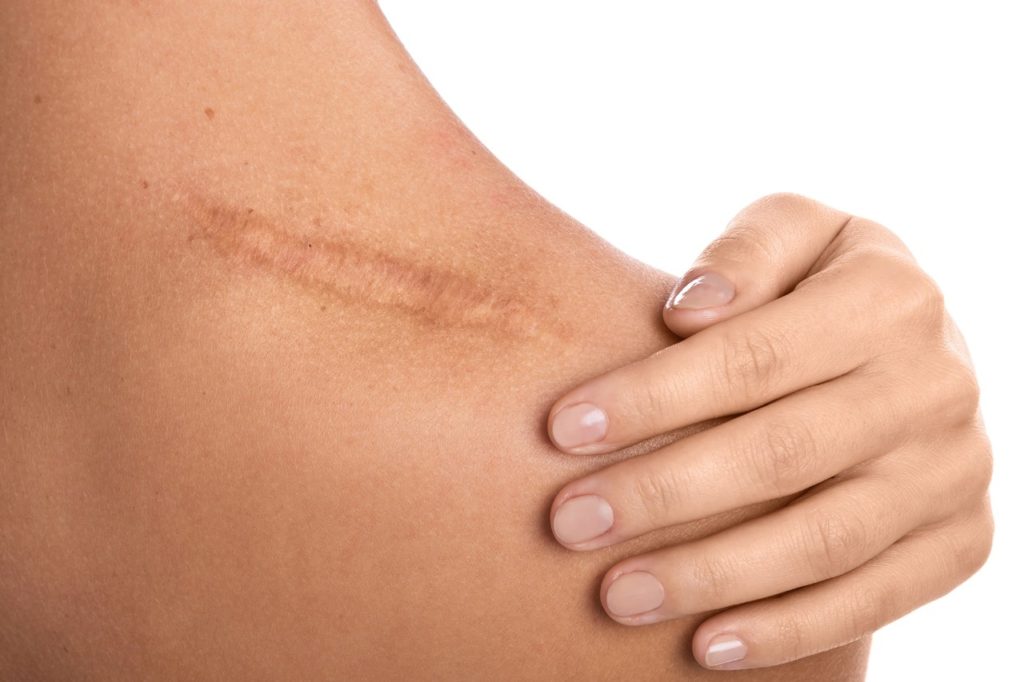In your lifetime you have probably accumulated one or more scars for various reasons. It could have been from surgery, an injury requiring stitches, a cyst removed, or you simply scraped your knee badly enough that it left a scar. Did it ever occur to you what effects scar tissue could have on your body as you age?
Byron, age 82, came to me complaining of shoulder pain and decreased shoulder range of motion. Byron had a large lower left abdominal scar, after a temporary colostomy, which created soft tissue tension throughout his whole trunk and limited his ability to fully move his left arm. Not unlike a loose thread in a sweater that, when pulled on, pulls the sweater towards your neck or arm. In addition to exercises, Byron received manual therapy for his scar, then he enjoyed less pain and improved mobility.
Nancy, age 78, had lower back pain. She had a right upper abdominal scar because of a gallbladder removal 60 years ago. As a part of her treatment, we manually worked on her scar tissue, which allowed her pelvis to move more freely and decreased her lower back pain.
What Is Scar Tissue?
Scar tissue is more than just a discoloration of the skin.
Our bodies are like self-repairing machines. T-cells attack viruses when they infiltrate our immune systems, and healthy arteries enlarge when they get clogged. Similarly, when we sustain injuries or undergo surgeries that break the skin, systems inside develop remedies to address the wounds. After a severe cut, the body repairs the damage by producing what we call scar tissue.
Related Resource: Physical Therapy After Surgery
Scar tissue forms when cells and collagen collect over the site where the injury occurred. They leave a ridged, pink, or flesh colored area of skin known as scar tissue. Although some scar tissue heals quickly and has no significant long-term effects, sometimes scar tissue remains itchy or painful for months or years following the injury. In addition, as in Byron’s case, it eventually can lead to mobility limitations and pain elsewhere in the body.
What Does Scar Tissue Do to Normal Tissue?
Although scar tissue closes your wounds and helps with the healing process, it can and probably will affect other tissues, your mobility, and your ability to function. You grow new tissue to fill the space created by the injury. This will have an impact on normal tissue. There are several types of scar tissue, and each of them has a different impact on your skin.
- Contracture: After a burn, contracture scars make your skin contract or tighten. This type of scar limits your movements, particularly when the tissue gets into nerves or muscles, or when it builds over a joint.
- Stretch marks: Skin that shrinks or expands may damage connective tissue under the skin. Stretch marks are common during puberty, pregnancy, or when a person loses or gains lots of weight.
- Keloids: Keloid scars rise above the skin and spread past the wound. They may affect a person’s movements.
- Raised (hypertrophic): Raised scars shrink in time, but they do not flatten out. They are similar to keloids except they don’t grow beyond the wound.
Scar tissue’s influence on normal skin can be problematic. Jenna, age 36, developed excruciating lower pelvic pain when she was six months pregnant. This is not an unusual condition to have during pregnancy. For most, pelvic pain is easy to manage. But Jenna’s condition was complicated by a C-section scar on her lower abdomen and a history of multiple gynecological procedures. I determined the scar tissue was not stretching with her growing belly and likely adhered to her pubic bone. Throughout her pregnancy, Jenna received manual therapy to the scar, which allowed her to resume life with minimal restrictions and occasional mild pain. When she gave birth to a healthy baby girl via the same c-section scar, her doctor cleaned up the scar tissue attached to her abdomen with a laser.
How Do You Treat Scar Tissue?
In Jenna’s case, like so many others, scar tissue was more than a topical issue. It wasn’t just a mark on her body. It was much more painful. Scar tissue can be insidious. It will continue to grow, even developing what seem to be tentacles throughout the affected areas. For example, an abdominal scar often attaches itself to neighboring tissues. This creates at the very least limited mobility and pain in the back or other joints, or at the worst develops adhesions in the abdomen which disrupt bowel functions. When these serious adhesions happen, people will often need surgery to get rid of the scar tissue. Ironically, surgeries create more scar tissue.
We saw Janet, age 59, before and after a total right hip replacement. She had a history of gynecological surgery for endometriosis, which left her with quite a bit of abdominal scar tissue. Through evaluation we determined that her limited spinal mobility, particularly while walking, and occasional low back pain were related to the significant abdominal scar tissue. Janet received manual therapy to her abdominal scar tissue. The treatment allowed for better spinal movement, an improved gait (walking), and less pain.
Guidelines for Treatment
How we approach scar tissue treatment depends on the acuity or age of the scar.
- Initial to week 6: Do not massage the scar directly. Instead, gently massage all around the scar.
- Week 3-6: If the scar is fully healed and closed, it’s OK to lightly rub it with vitamin E cream or oil.
- Weeks 6-8: Gentle to moderate massage to the scar is allowed.
- After 8 weeks: There are no restrictions or precautions, other than your tolerance, to the amount of pressure applied to the scar.
To help self-manage the scar long term, you can try:
- Self myofascial release to the scar and the surrounding tissues. Learn more about the topic by watching a video about MFR
- Gentle massage to the scar and the surrounding tissues
- The OOV – one of the benefits of using the OOV is that it helps old scars by releasing myofascial restrictions throughout your body. The old scar tissue and myofascial restrictions are like kinks in a garden hose that prevent water from flowing. Until the kink is removed, you will not have flowing water.
- Get regular massages with a massage therapist
- Do daily dynamic mobility exercises
- Yoga
- Pilates
Sometimes scars seem so small that you can barely see them. You might think those can’t be a problem, but they can still cause major issues.
Ann, age 78, came to us with chronic right hip and back pain, and excessive lumbar lordosis (an excessive inward curve of the spine). She had a history of a minor gyne procedure, done over 40 years earlier, through her umbilicus (belly button). We performed manual therapy to her 40-year-old umbilical scar, which reduced her lordosis to normal, and improved her quality of movement and pain management.
When patients see us for physical therapy, they are often surprised that we want to know all their surgical history. We know, and now you know too, that scar tissue may be one piece of the puzzle to address issues limiting your mobility and lowering your quality of life.
Whether you’re managing scar tissue in the short or long term, at The Manual Touch, we are ready to help.







Leave a Reply